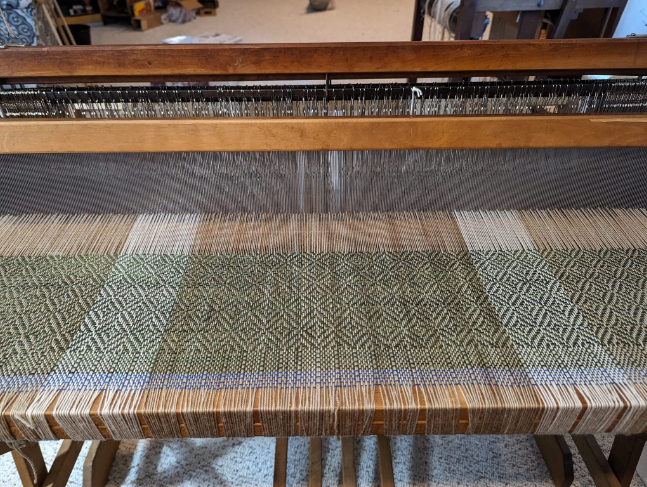One of the richest resources for Viking Age textiles is the Oseberg Ship. For this project I was inspired by extents found in the following article: The textiles in the Oseberg ship By Anne Stine Ingstad
I had the pleasure of joining a Forest Court event at the end of 2022. One of my favorite humans was leading a mini workshop on using the acorn leech water to make dye. We added skeins of cotton and wool to the dyepot, as well as some Cheviot wool roving. After a brief simmer, iron mordant was added and the color shifted to a lovely deep lilac brown. This was my first foray into dyeing with foraged materials.
After a few snacks of acorn cakes, we embarked on a woods walk. As we walked, I noticed a surprising amount of lichens around – much of it was no longer attached (thus no longer functioning as a decomposer). Once upon a time I had heard of a lichen that would produce a vibrant
magenta dye. I had no idea what kind of lichen that was, but it couldn’t hurt to collect what was there. I brought it home, washed it, and began fermenting it in an ammonia solution.
After about 6 weeks, I had a dye stock that appeared to be a deep, reddish brown. Now just to be brave enough to see what the tannins in the lichen will do to bare fiber.
Since the lichen was gathered at a Forest Court event, it seemed only fitting to dye the yarn at a forest court event. I dyed a test skein to see if I wanted to use a mordant to modify the color, and decided that it washed out far too pale for my taste. I added an iron mordant, and while the color is still out of my comfort zone I decided it would suit if I used a deep enough green to weave against it.
It was too much fun to dye yarn over a fire in the middle of a snow covered forest at Otzi’s Paradise. As fortune would have it, we forgot the lid for my dye pot, so we covered it with a shield to keep the temperature up.
In the articles I skimmed through, many researchers were confused by this warp pattern. I suspect it is because weaving is not a common skill, even among crafters and fiber artists.
As soon as I saw the pattern, I recognized it and pulled out my trusty warp dictionary. The warp threading is the same as for classic herringbone twill. The difference here is that it is a “trompe as writ” pattern – meaning that the shafts are lifted in the same pattern as the the warp is threaded.
When I dyed the warp at Otzi’s, one of the skeins settled to the bottom and cooked itself apart. I had more yarn, and more dye. But I couldn’t replicate the original color (must have been the snow covered forest).
I decided to incorporate it as a design element instead of mistake. I like the way the deep green plays against the browns of the lichen.
Most extant pieces we have, it is not always clear how the ends have been finished. I intended to braid or twist the fringe on this brat. But after testing and soliciting opinions from a local craft group, we decided it looked better to leave the fringe loose. There is one extant piece I know of that is dyed with indigo and has knotted fringe. It is still undergoing investigation. As a weaver, it is the easiest way to finish a length of cloth, but fringe is not always appropriate for the purpose of the cloth.
I made it to 100 inches (20 more than planned) before I called it quits on this project. It’s more than generous and will be plenty long enough to wear as a hooded wrap for the Forest Court.
I like that ties in the disruptive coloration that so many birds have developed as ways to hide in the woods.
See pictures and more details here.

I love that you foraged the lichen and did the dye works outdoors! Great project! I’m looking forward to seeing more!